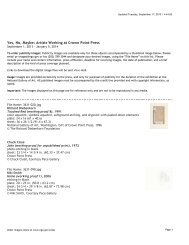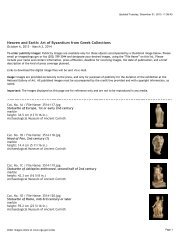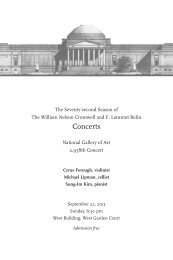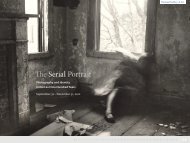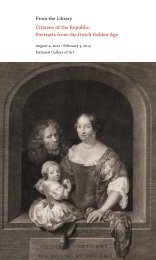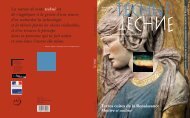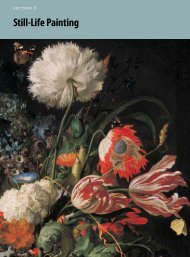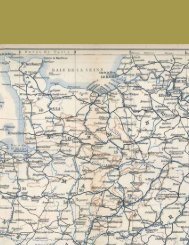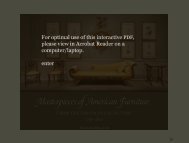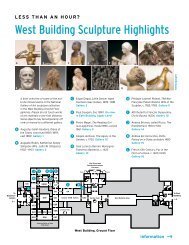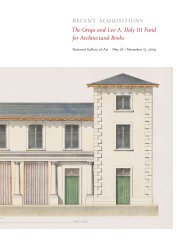Download Report - National Gallery of Art
Download Report - National Gallery of Art
Download Report - National Gallery of Art
You also want an ePaper? Increase the reach of your titles
YUMPU automatically turns print PDFs into web optimized ePapers that Google loves.
entire career. Through one <strong>of</strong> the most turbulent periods<br />
in European history that included two world wars, the<br />
Spanish Civil War, and the decades-long dictatorship <strong>of</strong><br />
Francisco Franco, Miró maintained a fierce devotion to<br />
his native Catalonia in northern Spain. Miró developed<br />
a visual language that reflected his vision and energy in a<br />
variety <strong>of</strong> styles across many media. A critical work in the<br />
exhibition was The Farm, 1921–1922, a painting Miró<br />
regarded as a key work in his career that combines memories<br />
<strong>of</strong> his home in Mont-roig with elements <strong>of</strong> cubism,<br />
abstraction, and primitivism. Ernest Hemingway purchased<br />
The Farm shortly after it was painted, and in 1987,<br />
Mary Hemingway donated it as a gift to the <strong>Gallery</strong>. Ten<br />
<strong>of</strong> Miró’s lyrical constellation series works were installed<br />
on a specially constructed, gentle-curving wall painted<br />
midnight blue. A series <strong>of</strong> forty lithographs were juxtaposed<br />
with one large-scale triptych, making an interesting<br />
contrast in scale. A fully illustrated catalogue and film<br />
accompanied the exhibition. Made possible by The HRH<br />
Foundation, the thirty-minute film was produced by the<br />
<strong>Gallery</strong>, narrated by Ed Harris, and shown at the <strong>Gallery</strong><br />
and on PBS television stations. With original footage shot<br />
in Barcelona and at the Miró family farm in the Catalonian<br />
countryside, it chronicled the artist’s longing for escape<br />
from the chaos <strong>of</strong> war into pure creativity.<br />
Another <strong>Gallery</strong>-owned work formed the centerpiece<br />
<strong>of</strong> the exhibition Deacon Peckham’s “Hobby Horse.” When<br />
The Hobby Horse, c. 1840, was given to the <strong>Gallery</strong> in<br />
1955 by Colonel Edgar William and Bernice Chrysler<br />
Garbisch, the artist’s identity was unknown. Decades <strong>of</strong><br />
research by <strong>Gallery</strong> staff led to a formal attribution to<br />
EXHIBITING<br />
26<br />
George Bellows<br />
Robert Peckham (1785–1877) in 2009. Along with this<br />
important painting, eight <strong>of</strong> the most vibrant and arresting<br />
<strong>of</strong> Peckham’s portraits <strong>of</strong> children from four museums and<br />
several private collections were exhibited together for the<br />
first time. The exhibition also featured a rare nineteenthcentury<br />
rocking horse similar to the one depicted in The<br />
Hobby Horse. Related works from the permanent collection<br />
were included in an adjacent gallery. A brochure<br />
published on the <strong>Gallery</strong>’s website contained an essay on<br />
Peckham’s career, a catalogue <strong>of</strong> the works on view, and a<br />
chronology <strong>of</strong> all known paintings by the artist.<br />
The first comprehensive exhibition <strong>of</strong> the career <strong>of</strong><br />
George Bellows (1882–1925) in more than three decades<br />
premiered at the <strong>Gallery</strong> this fiscal year. Bellows painted the<br />
world around him. He was also an accomplished graphic<br />
artist whose illustrations and lithographs addressed a wide<br />
array <strong>of</strong> social, religious, and political subjects. Including<br />
some 130 paintings, drawings, and lithographs, George<br />
Bellows presented his full range <strong>of</strong> remarkable artistic<br />
achievement thematically and chronologically throughout<br />
nine rooms in the West Building. A fully illustrated catalogue,<br />
an audio-tour, and a thirty-minute film produced<br />
by the <strong>Gallery</strong> accompanied the exhibition. Narrated by<br />
Ethan Hawke with original footage shot in New York<br />
and Maine, the film captured the breadth <strong>of</strong> Bellows’<br />
interests, from the rapidly growing modern city to the rugged<br />
beauty <strong>of</strong> the Maine seacoast. Made possible by The<br />
HRH Foundation, the film was screened at the <strong>Gallery</strong>




